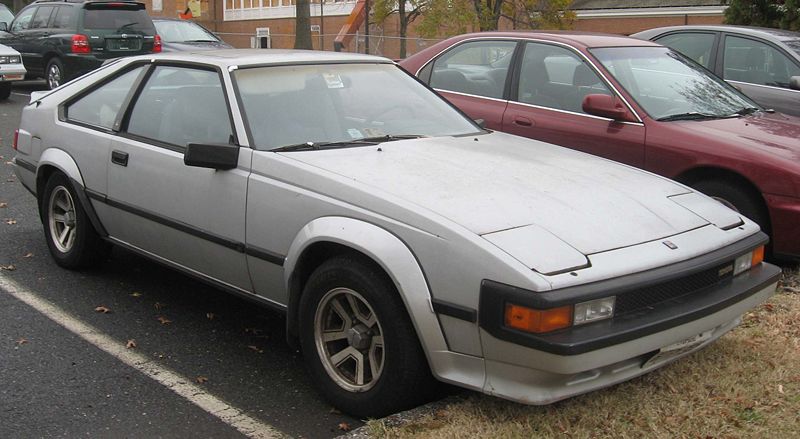
MKI Supra
The Supra was introduced in 1979 as the Celica Supra as it was a model based heavily on the 4cyl Celica. In fact, all body panels aft of the front fenders was from the Celica. The only difference was the longer nose of the car necessary to house the inline 6cyl engine standard on the Supra. Japanese models received a 2.0L engine and US models came with a 2.6L. Both engines produced 110HP and were the first engines from Toyota to feature electronic fuel injection. Suspension comprised of MacPherson struts in front with a 4 link solid axle in the rear. Transmission choices were a 5 speed manual or a 4speed auto, both with overdrive. In 1980 the Japanese market Supra was offered with a 145HP turbo inline 6cyl, the first turbo engine ever from Toyota. The MKI Supra ended production after 1981. That year the engine was upgraded to 2.8L and 116HP.

MKII Supra
In 1982, the second generation Supra was released with all new styling, a new engine, new transmission, and new suspension. The car was still based on the newly redesigned Celica but it looked much different. The new 2.8L DOHC 5M-GE engine produced 145HP/155TQ. The suspension was now 4 wheel independent and designed with the help of Lotus. The second gen Supra was available in two trim levels, luxury and performance. The performance models can be distinguished by their fiberglass fender flares. Power continued to rise throughout the years. In 1983, horsepower went to 150 and then 1984 saw it bumped up to 160. Finally in 1985, power reached it's peak for the MKII cars at 161HP/169TQ. Second gen production came to an end in 1985 but a surplus of cars and delays with the new Supra model lead to the car being sold into 1986.

MKIII Supra
The MKIII Supra debuted in mid 1986 as an 1986.5 model. Again the car was completely redesigned and no longer shared a platform with the Celica which had changed to front wheel drive. The Supra now used the 7M-GE and 7M-GTE engines in US spec. The naturally aspirated 3.0L 7M-GE produced 200HP in 1986 and the 7M-GTE turbo engine, introduced in 1987, made 230HP. Power for the 7M-GTE eventually rose to 232HP/254TQ in 1989 due to improvements in the turbo system. As usual, the Japanese market was treated to a couple of special editions of the MKIII Supra throughout it's production. The JZA70, known as the 2.5GT Twin Turbo, featured a new engine, the 1JZ-GTE, which produced 280HP. The GA70 model used a 2.0L 210HP twin turbo 1G-GTE. Special 2.5 Twin Turbo R JZA70 models featured Recaro seats, torsen differentials with additional bracing, Bilstein suspension, and Momo steering wheels and shift knobs. The Twin turbo R was the fastest of the MKIII Supras.

MKIV Supra
Toyota took a big leap in technology and performance in 1993 with the release of the 4th generation Supra. The car's body was redesigned for aerodynamic efficiency and it made use of two new engines, the 2JZ-GE and 2GZ-GTE. Still inline 6cyl engines displacing 3.0L, they produced 220HP/210TQ in the naturally aspirated 2JZ-GE and 320HP/315TQ in the twin turbo 2JZ-GTE. The turbo Supra could now sprint to 60 in under 5 seconds and clear the 1/4 mile in the low 13s. Unrestricted, the car could reach over 180mph. All this despite the fact that the car's weight had grown to 3,505lbs for the turbo model with targa roof. A new Getrag 6spd manual was used on the Supra Turbo while NA cars made due with a 5spd. In 1996 the turbo was only available with the auto transmission due to the switch to OBD-II. In 1997, the 6speed returned along with minor exterior changes in taillights, wheels and fascia. US sales of the Supra ended in 1998 while production continued in Japan until 2003.
The MKIV Supra has become somewhat of a legend since it was discontinued here in the US. It has a huge enthusiast following which has only grown as the Fast & Furious crowd has become aware of the car's potential. Mostly due to it's prominent role in the first of the awful Fast & Furious movies. The 2JZ-GTE engine is an amazing powerplant that takes quite well to modifications. Supras boasting over 1000HP are not that uncommon which is a testament to the strength of the 2JZ. Because of this, prices for used MKIV Supras are still well over $20,000 and upwards of $40,000 for nicer examples. Sadly, expect to deal with someone's modifications as finding an unmolested example is getting harder and harder. Also, they are seen more and more as being the vehicle of choice for some incredible douchebags. Remember, this is the car that Nick Hogan (Hulk's son) crashed spectacularly while street racing, resulting in the near death of his friend and jail time for Nick.

Toyota FT-HS concept
There have been rumors that Toyota had been working on a new Supra. There seemed to be hope when Toyota unveiled the FT-HS hybrid sportscar concept but eventually those rumors were proven to be not true. Even if Toyota had been working on a new Supra, it would have been killed by now due to the dreadful state of the world economy. The best chance would have been a slightly less exotic sportscar based on the Lexus LF-A but, sadly, that project has been scrapped due to the economy.

















No comments:
Post a Comment